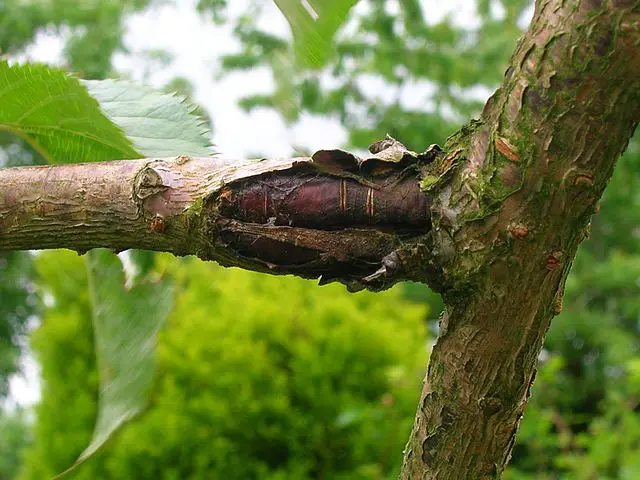Bacterial canker affects trees in the Prunus family, including plums, cherries, apricots, and peaches. Scientifically named Pseudomonas syringae, this disease is responsible for many cherry and plum trees failing to survive or produce a healthy fruit yield. The cankers that form can be visible from springtime and are caused by bacteria entering the wood where the leaves form.

Rosser1954, CC BY-SA 3.0 , via Wikimedia Commons
Symptoms of bacterial canker include dead bark, holes in leaves, and oozing gum being visible. This bacteria can kill a whole tree if left untreated and it’s during the spring months this disease spreads most rapidly.
Jump To...
Bacterial Canker Symptoms
Being aware of the signs and symptoms of bacterial canker can help stop the disease from spreading throughout the entire tree. You should monitor for the following symptoms:-
- You might notice some dead areas of bark during the spring and summer months.
- Branches and stems might look malformed and have areas that appear sunken. The size of these dead areas can change considerably from small to large.
- You may see some dark coloured gum oozing from affected areas and this may turn hard.
- Leaves may turn yellow with brown spots and eventually get small holes in them. This is known as shot hole.
- Shoots may fail to grow or may begin to grow and then die. Again, this can be localised or it can affect a larger area.
It’s important not to confuse bacterial canker symptoms with some other issues that fruit trees can be susceptible to. For example, oozing gum can also be a result of environmental factors and not necessarily a disease.
This bacteria seems to commonly affect young plum trees, but other fruit tree types can also be affected.
Bacterial Canker Treatment & Control
Treatment for bacterial canker can involve being very harsh and thorough with your tree. You might need to be prepared to lose large parts of it to get the bacteria gone. Control of this disease can be something as simple as knowing the correct times to prune and tend to your tree.
Control Bacterial Canker
To control bacterial canker you will need to cut back any diseased branches and shoots. You will need to make sure you go far back, right into the good wood. You should also aim to burn anything you remove to stop the disease from reinfecting itself. This also goes for any leaves that fall off during the pruning process.
Keeping your equipment clean and sterile in between uses will also help a great deal. Should the bacteria spread to the truck itself then you will need to burn your tree completely. Should you decide to plant another, choose a new spot in case any bacteria remains in the ground. Prune your tree at the correct times of year to avoid making your tree more vulnerable.
Pesticide Treatments
Several fungicides are on the market that may help with bacterial canker but there is no firm scientific evidence as regards the effectiveness of fungicide to treat bacterial canker.
Bacterial Canker Lifecycle
Bacteria enter the bark through fallen leaves in the summer. This infection will grow during autumn, picking up speed during the spring. Cankers will grow bigger and bigger before lying dormant, beginning the lifecycle again in the autumn.
Further Reading
Our guide on common plum tree infections and infestations will help you diagnose if you have a problem with your tree, and how to treat it.

I have huge bacterial cankers on my peach tree at the base of most of my limbs effecting smaller limbs, leaves, and fruit in the Spring further up. What is the best fungicide to spray on my tree at this time of year of early February in Knoxville, TN and the best to spray at other times of the year to get rid of this stuff that has been killing my fruit production the last few years? Also, how many applications of these fungicides are necessary to to safely and effectively destroy this stuff?